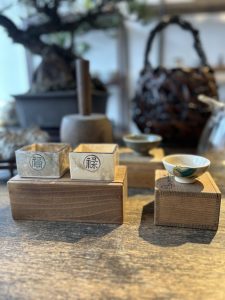春一番にはくれぐれもご注意ください(愛知県名古屋市千種区姫池通 古美術買取 古美術風光舎)
2025.02.12
寒波が少し緩んできた本日、関東で「春一番」が発表される可能性があるとのこと。
実は今年2月3日に、既に北陸地方で春一番が観測されており、観測史上最も早い発表なのだそうです。

ところで「春一番」、昔の歌謡曲の題名にもなっており、昭和世代にはかなり馴染みのある言葉かと思いますが、私、実はあまりよく理解しておりませんでした。名前の響きから春の訪れを感じさせる暖かい風をイメージしてしまいますが、どちらかというと強風が吹き荒れ、災害を引き起こす春の嵐ともいえる現象なのだそうです。暖かくなったからといって油断は大敵なのです。
立春を過ぎる頃、西高東低の冬型の気圧配置が緩み、太平洋側を通過していた低気圧が日本海側を通過するようになります。日本海を東に進む低気圧に向かって南風が一気に吹き込み、基準値を超える南風を観測した時に、各地の気象台から「春一番」が発表されます。
全国的に発表されるものだと思っていましたら、北海道、東北地方、長野県、山梨県、沖縄県では春一番の発表はないのだそうです。春一番後も冬型の気候が続いたり、すでに暖かい気候だったりと、それぞれの地域の気候の特性により発表の必要性がないのだとか。
また発表がある地域でも、風速7m、8m、10m以上と、春一番の定義が違うようです。基準を満たさない場合は「春一番の観測なし」となります。ちなみに東海地方では「風速8m以上、気温が平年より高い、日本海側で低気圧が発達」という定義だそうです。
気象庁による認定はありませんが、「春一番」の次は「春二番」「春三番」…と呼ばれ、春の季語ともなっています。
番号を付けていくとキリがないため、一般的に春の強風は「春嵐」や「春荒」「春疾風(はるはやて)」などと呼ばれます。
そもそも春一番の語源は、江戸時代1859年の春、長崎県壱岐市で53人の漁師の大量遭難を発生させた春先の強い突風が由来だとか。当時はこの強風を恐れて、海難防止の言葉として広まりました。壱岐市郷ノ浦では今でも旧暦の2月13日は、晴れていても出漁せず、海難者の「春一番供養」を行っているそうです。
現在では気象用語となっており、1963年2月15日、新聞で初めて「春一番」という言葉が使われたため、2月15日は春一番の記念日とされています。
春一番と聞くと、昭和世代の方々は往年のアイドルの曲をつい口ずさんでしまうのではないでしょうか。
すっかり誤解していたのですが、「春一番が掃除したてのサッシの窓に~♪」で始まる曲のタイトルが実は「微笑がえし」で、「雪が解けて川になって流れてゆきます~♪」が「春一番」というタイトルの曲だったのですね。
どっちでもいい、というお声が聞こえてきそうですが、前者の曲をずっと「春一番」だと思っていたのでちょっとした驚きでした。
重いコート脱いで出かけませんか♪ という歌詞もありますが、まだとてもコートを脱げる状況ではなく、春の訪れが待ち遠し今日この頃です。
それでは、また次の機会に。(スタッフH)
Today, when the cold wave has eased up a bit, the “first day of spring” may be announced in the Kanto region.
In fact, the first day of spring was already observed in the Hokuriku region on February 3 this year, making it the earliest spring storm in observation history.
By the way, “Haruichiban” is also the title of an old song, and the word may be quite familiar to the Showa generation, but I actually did not understand it very well. The name of the word conjures up images of warm breezes that remind us of the coming of spring, but it is actually a phenomenon of strong winds that can cause disasters, a spring storm. Just because the weather has become warmer does not mean that you should be careless.
Around the time Risshun passes, the winter pressure pattern of high in the west and low in the east slackens, and the low-pressure system that had been passing over the Pacific Ocean begins to pass over the Sea of Japan side. When the southerly winds blow in toward the low pressure moving eastward over the Sea of Japan, and the southerly winds exceeding the standard values are observed, the “first day of spring” is announced by the weather stations in each area.
I thought it was announced nationwide, but it turns out that the first day of spring is not announced in Hokkaido, Tohoku region, Nagano Prefecture, Yamanashi Prefecture, and Okinawa Prefecture. The first day of spring may be followed by wintery weather or already warm weather, so there is no need to announce the first day of spring due to the characteristics of each region’s climate.
Even in areas where announcements are made, the definition of the first day of spring seems to differ, with wind speeds of 7 m, 8 m, and 10 m or higher. When the criteria are not met, it is said that “the first day of spring is not observed. Incidentally, in the Tokai region, the definition is “wind speed of 8m or more, temperature is higher than normal, and low pressure develops on the Sea of Japan side.
Although there is no certification by the Japan Meteorological Agency, “the first day of spring” is followed by “the second day of spring,” “the third day of spring,” and so on, which are also seasonal terms for spring.
Since there is no end to the numbering, strong spring winds are generally called “spring storm,” “spring storm,” “spring gale,” “spring gale,” and so on.
The origin of the word “Haru-ichiban” is said to come from a strong gust of wind in early spring that caused the mass disappearance of 53 fishermen in Iki City, Nagasaki Prefecture, in the spring of 1859 during the Edo period (1603-1868). At the time, people feared these strong winds, and the term was popularized as a marine safety measure. In Gonoura, Iki City, people still do not go fishing on February 13 of the lunar calendar, even if the weather is fine, and hold a “Spring First Memorial Service” for those who have been lost at sea.
Today, it has become a meteorological term. On February 15, 1963, the term “first day of spring” was used for the first time in newspapers, and February 15 is considered to be the anniversary of the first day of spring.
Hearing the words “the first day of spring,” those of us of the Showa generation may have been humming the songs of the idols of yesteryear.
I had completely misunderstood that the title of the song, which begins with the words “The first day of spring is coming to the freshly cleaned sash window,” is actually “Smile back,” and the title of the song, “The snow melts and flows down as a river,” is “Haruichiban,” or “The first day of spring.
I can hear you saying that it doesn’t matter which one it is, but I was a little surprised because I had always thought the former song was “Haruichiban”.
There is a lyric that says, “Let’s take off our heavy coats and go out,” but I am not ready to take off my coat yet.
I am looking forward to the coming of spring. (Staff H)
*****************
ご実家の整理やお片付けなどをされている方のご相談などが多くございます。
お片付けなどくれぐれもご無理のないようになさってくださいませ。
風光舎では古美術品や骨董品の他にも絵画や宝石、趣味のお品など様々なジャンルのものを買受しております。
お片付けをされていて、こういうものでもいいのかしらと迷われているものでも、どうぞお気軽にご相談下さいませ。
また風光舎は、出張買取も強化しております。ご近所はもちろん、愛知県内、岐阜県、三重県その他の県へも出張いたします。
まずは、お電話お待ちしております。
愛知県名古屋市千種区姫池通
骨董 買取【古美術 風光舎 名古屋店】
TEL052(734)8444
10:00-18:00 OPEN
#出張買取#骨董#古美術#骨董品#絵画#版画#茶道具#刀剣#彫刻

